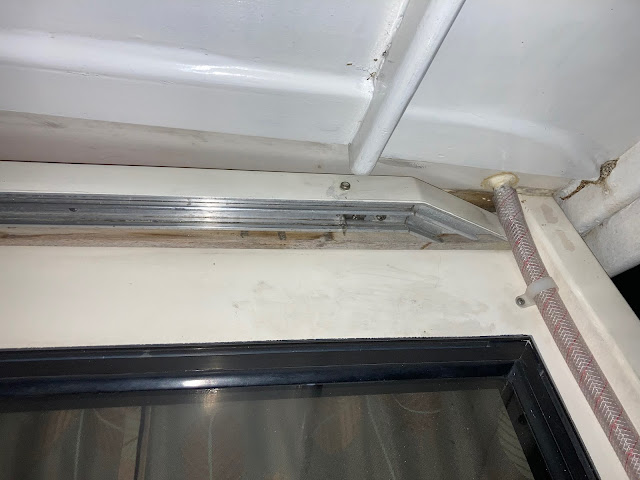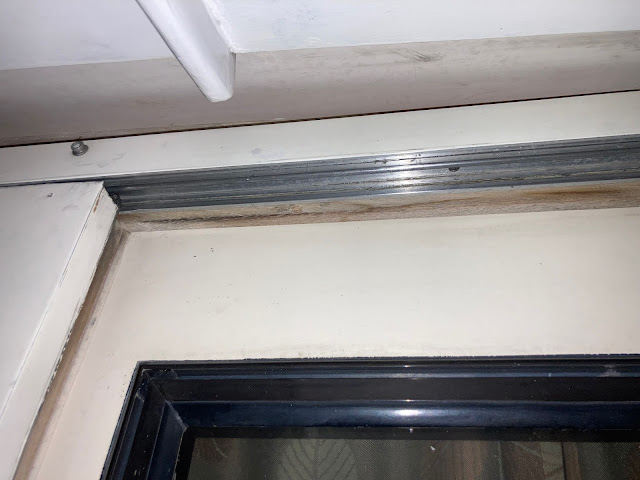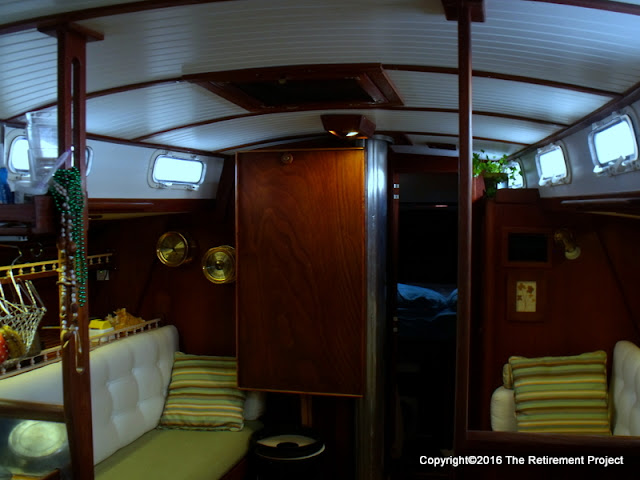Deb and I had long debates over the best way to provide some kind of auto-steering for
Kintala. As a long time commercial pilot I had visions along the lines of a capable Flight Management System: something that stores way points and routes, and holds a heading, track, or point of sail as required. Deb liked the idea of a wind vane. No power required, silent, acting very much in concert with the ethos of sailing. In the end we went with a Cape Horn wind vane. It has an excellent reputation for reliability and, just as important to us, the installation would not look like a child's jungle gym hanging off the back of our Tartan 42's very narrow stern.
The kit came complete so far as the wind vane hardware itself was concerned. But I was soon to discover that all of the hardware needed to have the vane actually move the rudder was "installer sourced", including the most important; that of the quadrant needed at the rudder post itself. The installation information was also somewhat sketchy so far as connecting the vane system to the rudder was concerned.
In addition to being a commercial pilot, I also spent a career as an aircraft mechanic, fabricator, troubleshooter, and inspector. To be perfectly honest, I'm not sure that, had I not had such a background, installing the Cape Horn on the Tartan would have been possible. It turned out to be a very involved job requiring fiberglass work, designing the control line runs through a very tight and somewhat busy area under the cockpit, and modifying parts of the boat to make the whole thing work.
What follows is the work involved in getting the Cape Horn installed on our boat, using the tools and skills I have. One can't be shy on a project like this as the first step is installing the transfer tube through the stern.

Step #1 - Cut a very big hole in the boat. I burned up several hole saws and took three days to bore the hole in the center of
Kintala's transom needed to install the transfer tube. The transfer tube is the heart and soul of the Cape Horn system, and must be aligned with the horizontal and longitudinal axis of the boat as near to perfect as possible. This is not easy on a boat floating in the water, with nary a straight or flat surface to use for reference. I used a 12 inch long, #10 bit to drill the pilot hole, then used the long drill sticking out of the hole to ensure the alignment. I drilled the pilot hole three times to get it right, and it still did not come out quite perfectly.
I started drilling the hole while the boat was at the dock, and finished it after the boat had been put up on the hard to wait on the truck.

The edge around the transfer tube was later sealed with black DC795
The transfer tube after installation but before glassing in
Once the transfer tube is located in place, support braces are
installed. There is an enormous amount of load carried through the tube
and by the braces, and they must be solidly mounted to the heavy
structure of the hull.
One of the support brackets mounted under the deck aft of the helm seat.
Looking down through the hatch on the stern deck behind the helm seat
At this point the tube has been sealed and glassed into the hull. The interior support brackets are bolted to the underside of the deck at the aft end of the cockpit.

The blade temporarily installed for alignment
Setting the exterior supports to brace the vane support tower. We had to order a slightly taller than standard tower in order for the vane itself to have clean air to work with above the bimini.
Various positions for the external support tubes were tried. This one ended up not working.
The forward end of the transfer tube is under the hatch.
The small rudder is twisted by the wind vane, causing the rudder to swing left and right, pivoting the transfer tube and, eventually, moving the rudder.
In the end, the external supports were mounted much higher and attached to the stern pulpit.
One of the two cleats needed for the vane's control lines. Originally we had them mounted on the aft deck, but that turned out to be an awkward placing. The vane is very sensitive, control line inputs are often just 1/8 to 1/4 of an inch, so good access makes life much easier. Some day I would like to mount them to a kind of "trim knob" (similar to an aircraft rudder trim), but...
Cleats for the main control lines that hook the transfer tube to the rudder. You can just see the lines coming out of the deck. This is aft of the helm and on the starboard side of the cockpit.
A better view with the lines taunt.
Access on the Tartan 42 is nothing short of ugly. Here I am working around the control lines while adding some supports to keep the lines from chaffing on cockpit drain tubes, clamps, and control cables from the helm to the rudder.
One of the two turning blocks that were glassed onto the inside of the hull. These lines take a substantial load and must be secure. I epoxied the blocks to the hull, then reinforced the bond with two layers of fiberglass cloth. I worked out the line runs using parachute cord. Taking extra time here to make sure the runs are clear and the angles are correct seemed a good idea. Moving the blocks once they were set in place would have been a nightmare.
This is the forward end of the transfer tube. The "V" shape in the picture is the quadrant mounted on the transfer tube which holds the control lines. The other end of the tube the quadrant is bolted to is driven by the water vane. That vane is twisted left or right by the wind vane flag inputs, causing the water flowing past the boat to swing the water vane, thus swinging the quadrant, pulling on the control lines, which pull on another quadrant bolted to the rudder tube. It isn't as complicated as it sounds.
Random picture of the transfer tube looking up with the quadrant mounted on the end of the tube. This is an ugly place to be in the Tartan 42, and a difficult place to work. These pictures give a hint of how crowded the space under the cockpit is. It took a while to figure out the line runs.

The line run under the cockpit. The quadrant can be positioned facing
up on the transfer tube or facing down, depending on the room available
in the installation area. That position of the quadrant on the transfer
tube determines whether the line run is straight or criss-crossed like
ours.
The large brass quadrant bolted to the rudder tube was left over from the original electric autopilot. I modified it by drilling off the large toothed sprockets that were riveted to the curved, forward, edge of the quadrant. The dimensions of this quadrant are a bit critical. We were lucky that the old one could be put to use. This is one of the major components in the system that Cape Horn does NOT provide. You get to figure this one out for yourself. The lines you see go to the quadrant on the transfer tube.
The
wind vane does not work motoring. After two years we took advantage of
the vane's design to incorporate the input from an ST1000 tiller pilot.
It ended up being a bit of a mickey-mouse affair where
Kintala,
literally, operates on a shoe string. But it works. It would be a much
more elegant design if Cape Horn provided a push-pull control cable that
matched the throw of the tiller pilot. (We tried to manufacture
something like it without success, so we ended up with the shoe string.)
The tiller pilot has to be mounted laterally in the boat, a problem
with the Tartan's narrow stern. This elevated shelf was the best we
could do given the limited space there was to work with. We could have
installed it under the deck, but that would have required a remote for
the tiller pilot that cost more than the tiller pilot itself.

The string goes from the rod on the tiller pilot across to this block, down through the deck and to the arm on the quadrant.
The
other end of the shoe string from the tiller pilot. The rod comes with
the Cape Horn kit. It sits in a small bracket at the forward end of the
transfer tube and replaces the input from the wind vane flag (which is
removed when using the tiller pilot.) The tiller pilot moves the rod,
which moves the water vane, which moves the tube, which moves the quadrant, which pulls on the control lines, which pulls on the quadrant
bolted to the rudder tube.
Here
is the small bracket that holds the rod for the tiller pilot. I had to
modify it by drilling a small hole in the side to take a set screw. The
rod was being pulled out of the bracket by the shoe string. An oversight
in the original design.
Weather cover for the ST1000

















































